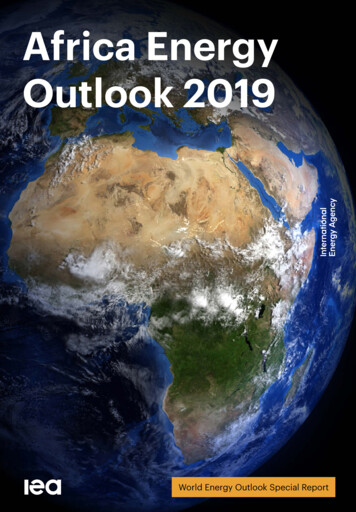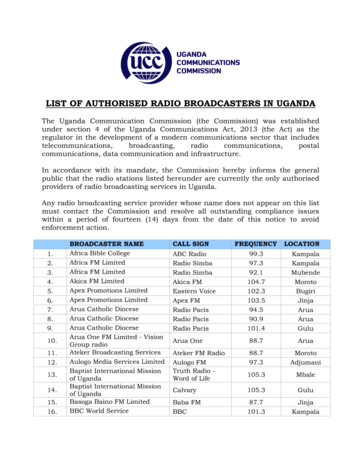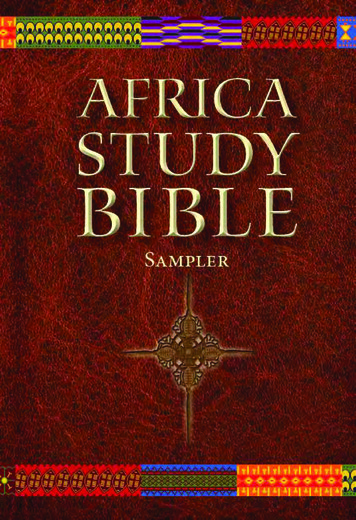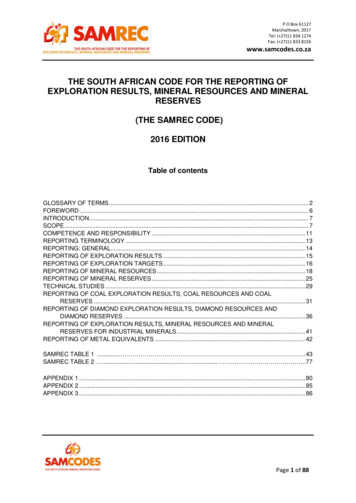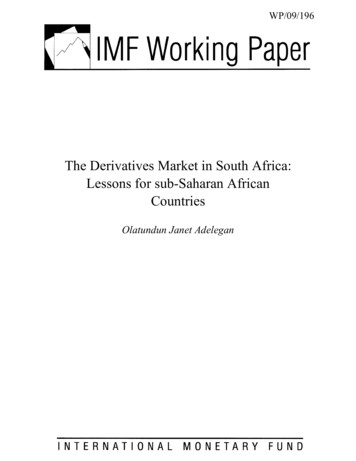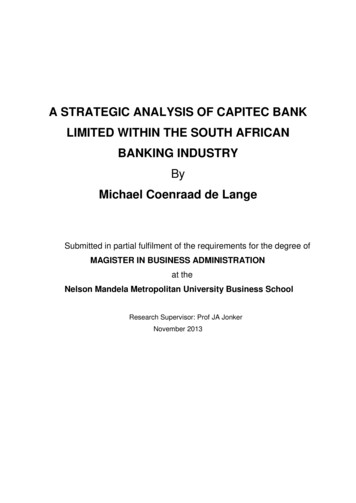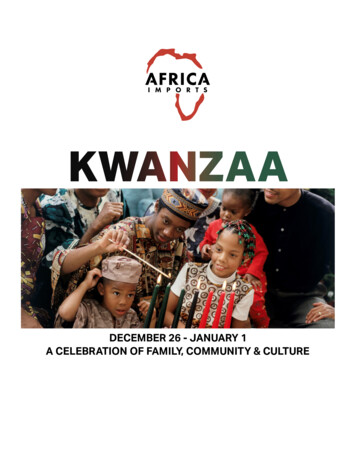
Transcription
KWANZAADECEMBER 26 - JANUARY 1A CELEBRATION OF FAMILY, COMMUNITY & CULTURE
Table Of Contents1.The Origin of Kwanzaa2.The Meaning of the Number 73.Red, Black & Green: The colors of Kuumba10.Imani
The Origin of KwanzaaThe name Kwanzaa is derived from the phrase “matunda ya kwanza” which means “first fruits”in Swahili.Each family celebrates Kwanzaa in its own way, but celebrations often include songs and dances,African drums, storytelling, poetry reading, and a large traditional meal.On each of the seven nights, the family gathers and a child lights one of the candles on the Kinara(candleholder), then one of the seven principles is discussed.The principles, called the Nguzo Saba (seven principles in Swahili) are values of African culturewhich contribute to building and reinforcing community among African-Americans.Kwanzaa also has seven basic symbols which represent values and concepts reflective of Africanculture. An African feast, called a Karamu, is held on December 31.
7The Meaning of the Number 7There are 7 Principles and 7 Primary Symbols that emphasize a unique set ofvalues and ideals during the 7 days of Kwanzaa also spelled with 7 letters.
Red, Black & Green: The colors of KwanzaaRed, Black and GreenThe colors of Kwanzaa are a reflection of the Pan-African movement representing“unity” for peoples of African descent worldwide.Black for the people, Red for the noble blood that unites all people of Africanancestry, and Green for the rich land of Africa.
Dec 26 - UnityUmoja (oo–MO–jah)To strive for and maintain unity in the family, community, nation, and race.Mazao, the crops (fruits, nuts, and vegetables)Symbolizes work and the basis of the holiday. It represents the historical foundation for Kwanzaa,the gathering of the people that is patterned after African harvest festivals in which joy, sharing,unity, and thanksgiving are the fruits of collective planning and work.Since the family is the basic social and economic center of every civilization, the celebrationbonded family members, reaffirming their commitment and responsibility to each other. In Africathe family may have included several generations of two or more nuclear families, as well as distantrelatives. Ancient Africans didn’t care how large the family was, but there was only one leader – theoldest male of the strongest group.For this reason, an entire village may have been composed of one family. The family was a limb of atribe that shared common customs, cultural traditions, and political unity and were supposedlydescended from common ancestors. The tribe lived by traditions that provided continuity andidentity.Tribal laws often determined the value system, laws, and customs encompassing birth,adolescence, marriage, parenthood, maturity, and death. Through personal sacrifice and hard work,the farmers sowed seeds that brought forth new plant life to feed the people and other animals ofthe earth. To demonstrate their mazao, celebrants of Kwanzaa place nuts, fruit, and vegetables,representing work, on the mkeka.
Dec 27 - Self-determinationKujichagulia (koo–gee–cha–goo–LEE–yah)To define ourselves, name ourselves, create for ourselves, and speak for ourselves.Mkeka: Place MatThe mkeka, made from straw or cloth, comes directly from Africa and expresses history, culture,and tradition. It symbolizes the historical and traditional foundation for us to stand on and buildour lives because today stands on our yesterdays, just as the other symbols stand on the mkeka.In 1965, James Baldwin wrote: “For history is not merely something to be read. And it does notrefer merely, or even principally, to the past. On the contrary, the great force of history comesfrom the facts that we carry it within us, are consciously controlled by it in many ways, andhistory is literally present in all that we do. It could scarcely be otherwise, since it is to history thatwe owe our frames of reference, our identities, and our aspirations.”During Kwanzaa, we study, recall, and reflect on our history and the role we are to play as alegacy to the future. Ancient societies made mats from straw, the dried seams of grains, sowedand reaped collectively. The weavers took the stalks and created household baskets and mats.Today, we buy mkeka that are made from Kente cloth, African mud cloth, and other textiles fromvarious areas of the African continent. The mishumaa saba, the vibunzi, the mazao, the zawadi,the kikombe cha umoja, and the kinara are placed directly on the mkeka.
Dec 28 - Collective Work and ResponsibilityUjima (oo–GEE–mah)To build and maintain our community together and make our brother’s and sister’s problems ourproblems and to solve them together.Vibunzi: Ear of CornThe stalk of corn represents fertility and symbolizes that through the reproduction of children,the future hopes of the family are brought to life. One ear is called vibunzi, and two or more earsare called mihindi.Each ear symbolizes a child in the family, and thus one ear is placed on the mkeka for each childin the family. If there are no children in the home, two ears are still set on the mkeka because eachperson is responsible for the children of the community. During Kwanzaa, we take the love andnurturance that was heaped on us as children and selflessly return it to all children, especially thehelpless, homeless, loveless ones in our community.Thus, the Nigerian proverb “It takes a whole village to raise a child” is realized in this symbol(vibunzi), since raising a child in Africa was a community affair, involving the tribal village, as wellas the family. Good habits of respect for self and others, discipline, positive thinking,expectations, compassion, empathy, charity, and self-direction are learned in childhood fromparents, from peers, and from experiences.Children are essential to Kwanzaa, for they are the future, the seed bearers that will carry culturalvalues and practices into the next generation. For this reason, children were cared forcommunally and individually within a tribal village. The biological family was ultimatelyresponsible for raising its own children, but every person in the village was responsible for thesafety and welfare of all the children.
Dec 29 - Cooperative EconomicsUjamaa (oo–JAH–mah)To build and maintain our own stores, shops, and other businesses and to profit from themtogether.Mishumaa Saba: The Seven CandlesCandles are ceremonial objects with two primary purposes: to re-create symbolically the sun’spower and to provide light. The celebration of fire through candle burning is not limited to oneparticular group or country; it occurs everywhere. Mishumaa saba are the seven candles: threered, three green, and one black. The back candle symbolizes Umoja (unity), the basis of success,and is lit on December 26.The three green candles, representing Nia, Ujima, and Imani, are placed to the right of the Umojacandle, while the three red candles, representing Kujichagulia, Ujamaa, and Kuumba, are placedto the left of it. During Kwanzaa, on candle, representing one principle, is lit each day. Then theother candles are relit to give off more light and vision. The number of candles burning alsoindicate the principle that is being celebrated. The illuminating fire of the candles is a basicelement of the universe, and every celebration and festival includes fire in some form. Fire’smystique, like the sun, is irresistible and can destroy or create with its mesmerizing, frightening,mystifying power.Mishumaa saba’s symbolic colors are from the red, black, and green flag (bendara) created byMarcus Garvey. The colors also represent African gods. Red is the color of Shango, the Yorubagod of fire, thunder, and lightning, who lives in the clouds and sends down his thunderboltwhenever he is angry or offended. It also represents the struggle for self-determination andfreedom by people of color. Black is the people, the earth, the source of life, representing hope,creativity, and faith and denoting messages and the opening and closing of doors. Greenrepresents the earth that sustains our lives and provides hope, divination, employment, and thefruits of the harvest.
Dec 30 - PurposeNia (nee–YAH)To make our collective vocation the building and developing of our community in order to restoreour people to their traditional greatness.Kinara: The CandleholderThe kinara is the center of the Kwanzaa setting and represents the original stalk from which wecame: our ancestry.The kinara can be shape – straight lines, semicircles, or spirals – as long as the seven candles areseparate and distinct, like a candelabra. Kinaras are made from all kinds of materials, and manycelebrants create their own from fallen branches, wood, or other natural materials.The kinara symbolizes the ancestors, who were once earth bound; understand the problems ofhuman life; and are willing to protect their progeny from danger, evil, and mistakes. In Africanfestivals the ancestors are remembered and honored. The mishumaa saba are placed in thekinara.
Dec 31 - CreativityKuumba (koo–OOM–bah)To do always as much as we can, in the way we can, in order to leave ourcommunity more beautiful and beneficial than we inherited it.Kikombe Cha Umoja: The Unity CupThe kikombe cha umoja is a special cup that is used to perform the libation (tambiko) ritual duringthe Karamu feast on the sixth day of Kwanzaa. In many African societies libation are poured forthe living dead whose souls stay with the earth they tilled.The Ibo of Nigeria believe that to drink the last portion of a libation is to invite the wrath of thespirits and the ancestors; consequently, the last part of the libation belongs to the ancestors.During the Karamu feast, the kikombe cha umoja is passed to family member and guests, whodrink from it to promote unity. Then, the eldest person present pours the libation (tambiko), usually water, juice, or wine, in the direction of the four winds – north, south, east, and west – to honorthe ancestors.The eldest asks the gods and ancestors to share in the festivities and, inreturn, to bless all the people who are not at the gathering. After asking for this blessing, the elder pours the libation on the ground and the group says “Amen.” Large Kwanzaa gatherings mayoperate just as communion services in most churches, for which it is common for celebrants tohave individual cups and to drink the libation together as a sign of unity.Several families may have a cup that is specifically for the ancestors, andeveryone else has his or her own. The last few ounces of the libation are poured into the cup ofthe host or hostess, who sips it and then hands it tothe oldest person in the group, who asks for the blessing.
Jan 1 - FaithImani (ee–MAH–nee)To believe with all our heart in our people, our parents, our teachers, ourleaders, and the righteousness and victory of our struggleZawadi: GiftsWhen we celebrate Imani on the seventh day of Kwanzaa, we give meaningful zawadi (gifts) toencourage growth, self-determination, achievement, and success. We exchange the gifts withmembers of our immediate family,especially the children, to promote or reward accomplishments andcommitments kept, as well as with our guests.Handmade gifts are encouraged to promote self-determination, purpose, and creativity and toavoid the chaos of shopping and conspicuous consumption during the December holiday season. A family may spend the year making kinaras or may create cards, dolls, or mkekas to give totheir guests.Accepting a gift implies a moral obligation to fulfill the promise of the gift;it obliges the recipient to follow the training of the host.The gift cements social relationships, allowing the receiver to share theduties and the rights of a family member. Accepting a gift makes the receiver part of the familyand promotes Umoja.
are called mihindi. Each ear symbolizes a child in the family, and thus one ear is placed on the mkeka for each child in the family. If there are no children in the home, two ears are still set on the mkeka because each person is responsible for the childr




